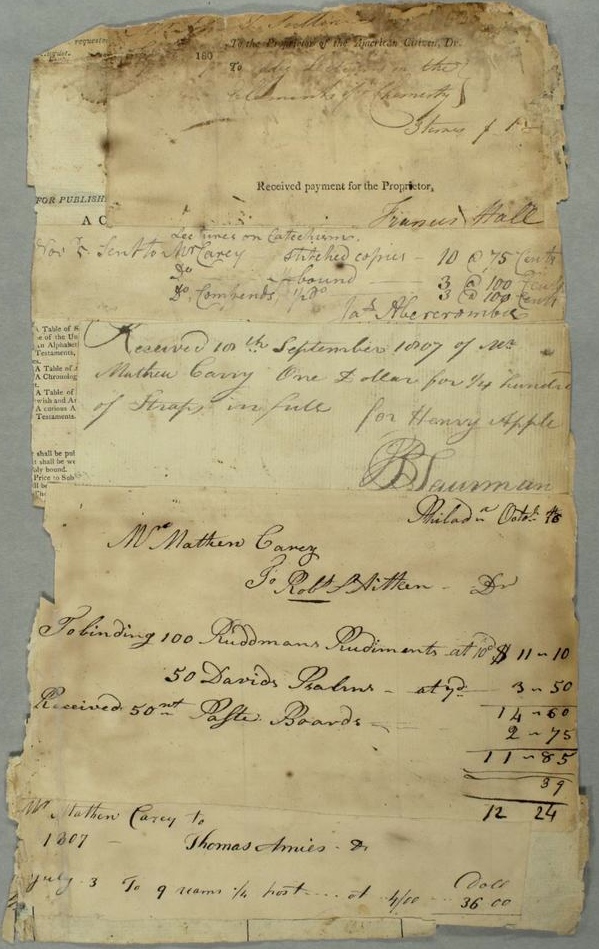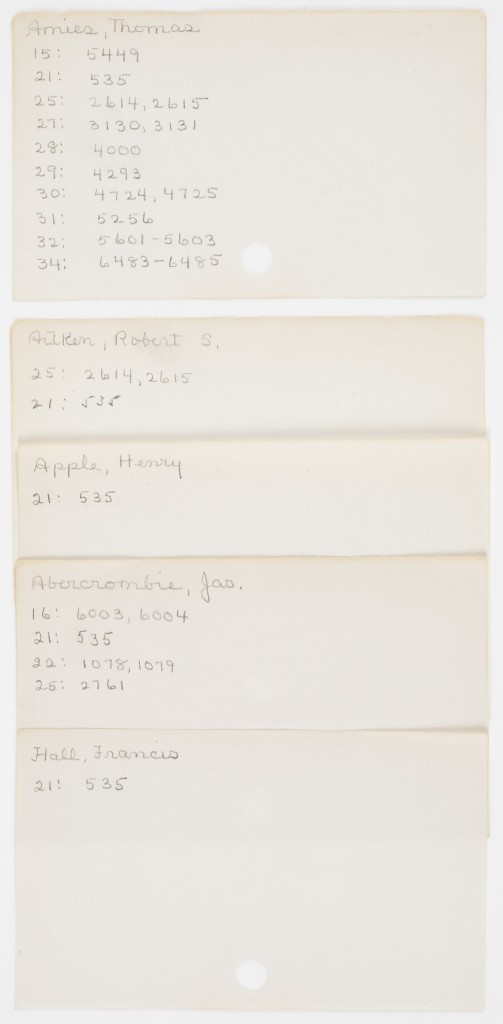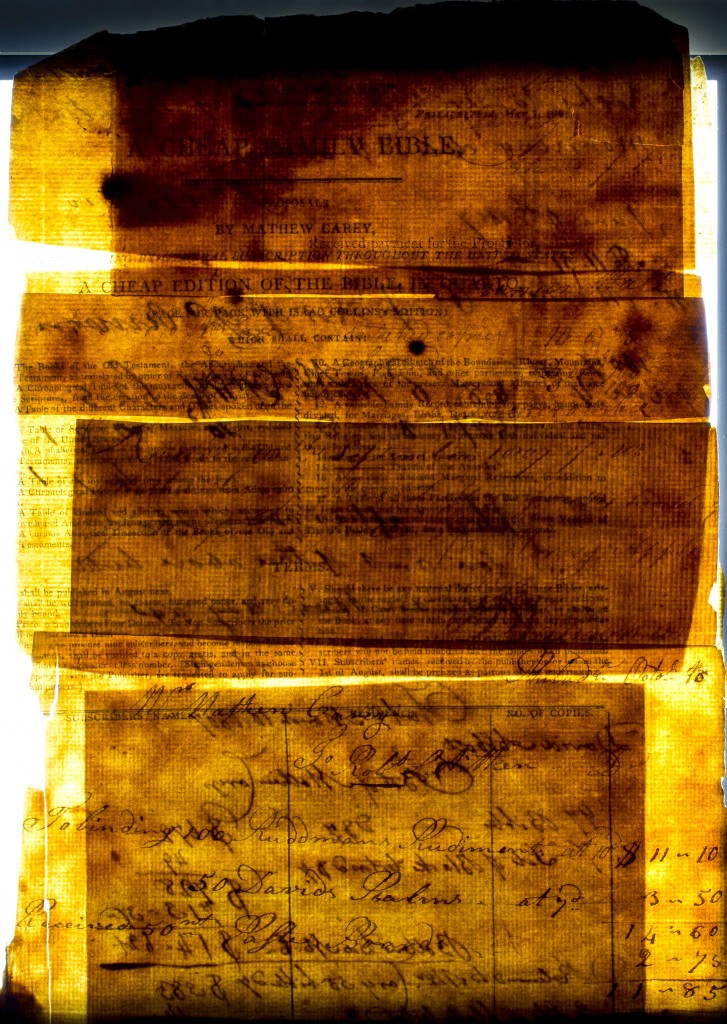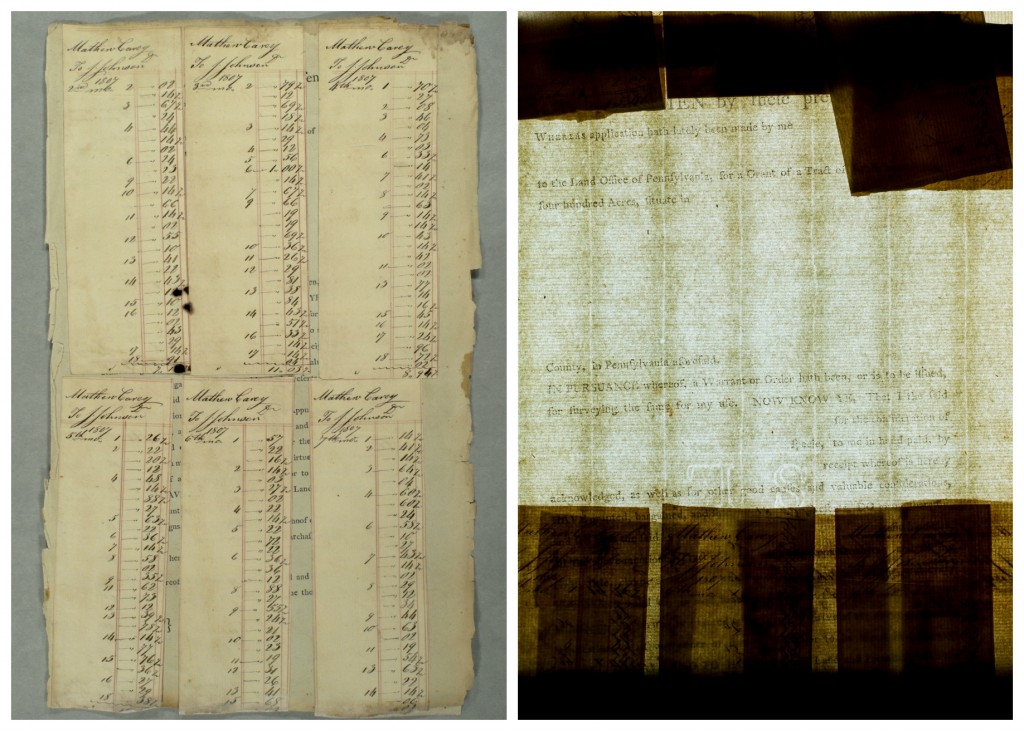Under cover of night on the Dublin docks in 1784, Mathew Carey, disguised as a woman, set sail for Philadelphia. Having spent the previous week hiding out in his friends’ bookshops along Grafton Street, Carey decided that this was the only sure way to escape the British officials who were in hot pursuit of him because of his unfavorable depiction of the Chancellor of the Exchequer in his radical newspaper. This printer turned polemicist turned newspaper editor turned publisher turned activist assumed many roles in his life, and fortunately for us, he ceaselessly wrote for most of that time. AAS holds a significant portion of his writing, in the form of his financial records from 1785-1847. They include receipts, bills, memoranda, invoices, bills of lading, and other records of his publishing business, and its successors: Carey, Lea, and Company; and Lea and Blanchard. These records not only detail Carey’s daily business dealings, but they also offer a window into the early American national and international book trade and larger worlds of trade and politics (see, for example, Vincent Kinane’s “‘Literary Food’ for the American Market: Patrick Byrne’s Exports to Mathew Carey” in The Proceedings of the American Antiquarian Society (1994)). As a recent special issue of Early American Studies reflects, Carey’s archive can help us to understand the politics, economics, and culture of early America through the lens of an extraordinarily successful businessperson. For example, Carey is credited with being the first to publish a bestseller in the United States, Susanna Rowson’s Charlotte Temple (1794) (see Michael Winship’s “Two Early American Bestsellers” in Common-place (2009)).
St. Patrick’s Day seems like a good time to take stock of this Irish émigré’s archive, parts of which are available at different levels of digital accessibility here at AAS. Having scanned the individual pages of the Carey financial records, we have made all 16,000 scans free to browse and download through our digital asset management system, GIGI. We are now beginning to consider the ways in which we will make these 16,000 images searchable, knowing that optical character recognition software is not yet up to the task of transforming these scrawls into searchable text. The work that we are doing now to make Carey’s business records navigable and therefore far more valuable to researchers relies on metadata that was created when AAS acquired this archive in 1928. And this work also raises questions around the threshold between metadata—or “data about data”—and the text or data proper. Where is the line between a text and the metadata about a text? When does that metadata become as important as the text itself?
 For example, let’s take a look at the physical pages onto which Carey’s records are pasted. As a publisher, Carey was well aware of the cost of paper, and thus reused spare sheets in creating his records. The waste paper to which Carey’s records are glued functions as a sort of “accidental paratext,” an addition to the text that mediates between the work of the author of the transactions and the publisher of the waste paper (Carey was both), but not intentionally so. When we examine this waste paper, we are essentially digging through Carey’s recycling bin, but this evidence is not readily visible in the digital surrogates.
For example, let’s take a look at the physical pages onto which Carey’s records are pasted. As a publisher, Carey was well aware of the cost of paper, and thus reused spare sheets in creating his records. The waste paper to which Carey’s records are glued functions as a sort of “accidental paratext,” an addition to the text that mediates between the work of the author of the transactions and the publisher of the waste paper (Carey was both), but not intentionally so. When we examine this waste paper, we are essentially digging through Carey’s recycling bin, but this evidence is not readily visible in the digital surrogates.
Let’s start with an image from the Carey archive that is available in GIGI. To the right is account #535, which was once a part of Accounts Volume 21 (when the books were disbound for scanning, it became part of Box 13, Folder 1).
This is a fairly typical looking page from the financial records in that it has a number of names and transactions listed on it. Shortly after acquiring this archive, Clarence Brigham hired a “special assistant to begin the tremendous task of making a name index to the entire series.” This index, which includes about 50,000 individual cards and occupies three card catalog drawers in the reading room, is the key to making use of this collection, whether one encounters it in manuscript form or online. The cards that might lead one to this leaf (or its digital surrogate) in Box 13, Folder 1 include:
 From these cards, one would learn an account number, which corresponds to a box and folder number in the finding aid. The finding aid has recently been augmented to include links to the images of each box and folder number, so that a user can scroll through about 10-20 images of the pages in that folder to find the account number she wants. We are currently in the process of keying the index cards into a spreadsheet; soon, we hope to make available both the spreadsheet and a database that can be used to run name searches. If we wanted information about early Bible printing in America, for example, we might have looked up the name “Aitken, Robert,” a printer of one of America’s earliest Bibles, on the index cards (soon to be in the online database) and found that one of the transactions between Carey and Aitken can be found in Box 13, Folder 1. But wait, there’s more!
From these cards, one would learn an account number, which corresponds to a box and folder number in the finding aid. The finding aid has recently been augmented to include links to the images of each box and folder number, so that a user can scroll through about 10-20 images of the pages in that folder to find the account number she wants. We are currently in the process of keying the index cards into a spreadsheet; soon, we hope to make available both the spreadsheet and a database that can be used to run name searches. If we wanted information about early Bible printing in America, for example, we might have looked up the name “Aitken, Robert,” a printer of one of America’s earliest Bibles, on the index cards (soon to be in the online database) and found that one of the transactions between Carey and Aitken can be found in Box 13, Folder 1. But wait, there’s more!
 If we scrutinize the high-resolution TIFF in GIGI of account #535, we can see that printed text is visible on the left margins. A backlighting of this page (left), which was presumably waste paper Carey had on hand, is an advertisement for Carey’s King James Bible (Carey also published the first version of the Roman Catholic Bible printed in the United States).
If we scrutinize the high-resolution TIFF in GIGI of account #535, we can see that printed text is visible on the left margins. A backlighting of this page (left), which was presumably waste paper Carey had on hand, is an advertisement for Carey’s King James Bible (Carey also published the first version of the Roman Catholic Bible printed in the United States).
This layering of a transaction between one of the first American Bible printers and advertisement for another prominent American Bible is largely serendipitous in this instance, but I mention it to show what we might uncover by examining the physical paper sheets that Carey used in making his records. In another instance (below), we can see Carey’s transactions with the prominent radical London publisher Joseph Johnson. The columns of numbers are barely discernable. But, when the researcher encounters the actual physical page, one quickly realizes that these columns lift up.
 Underneath is a blank form (presumably printed by Carey) from the Land Office of Pennsylvania for a tract of land for 100 acres and a receipt for the money paid for the land. What other scraps might one uncover under the pasted down accounts in Carey’s records? In a 1980 article in Book Collector, Marcus McCorison examined scintillating evidence about what Isaiah Thomas might have been printing but not recording based on marbled waste paper glued to the boards of various volumes here at AAS. What might one find if left to illuminate the waste paper Carey used as the foundation for his financial records? And, how might digitization account for that accidental paratext? It can only be photographed with the use of a special backlight, and unlike the name index we have on cards and are transforming to a spreadsheet, it cannot be organized and sorted in the same way. This waste paper can be read as revealing the limits of digitization, or as an invitation, made possible through digitization, to disrupt the hierarchy of the page and the information architecture that implicitly accompanies it.
Underneath is a blank form (presumably printed by Carey) from the Land Office of Pennsylvania for a tract of land for 100 acres and a receipt for the money paid for the land. What other scraps might one uncover under the pasted down accounts in Carey’s records? In a 1980 article in Book Collector, Marcus McCorison examined scintillating evidence about what Isaiah Thomas might have been printing but not recording based on marbled waste paper glued to the boards of various volumes here at AAS. What might one find if left to illuminate the waste paper Carey used as the foundation for his financial records? And, how might digitization account for that accidental paratext? It can only be photographed with the use of a special backlight, and unlike the name index we have on cards and are transforming to a spreadsheet, it cannot be organized and sorted in the same way. This waste paper can be read as revealing the limits of digitization, or as an invitation, made possible through digitization, to disrupt the hierarchy of the page and the information architecture that implicitly accompanies it.

2 thoughts on “Happy St. Patrick’s Day! The Mathew Carey Account Volumes: A Digitization Case Study”